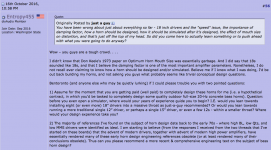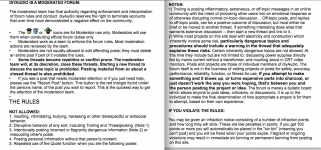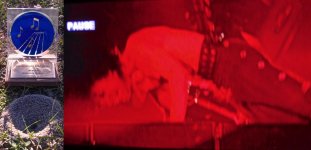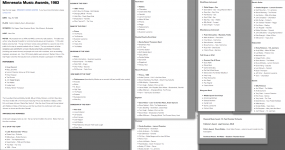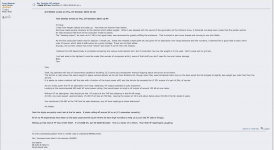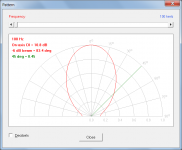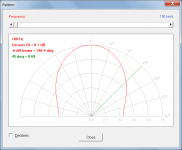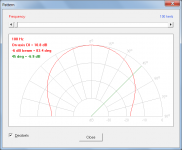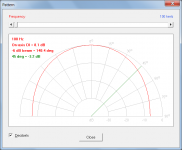Eventually, Eric may actually define the audio goals he desires to meet
Actually, he said quite a while back that
a) he wants to hear ~the concert sound that he has heard at (e.g. Red Hot Chili Pepper) gigs
b) he doesn't care so much about realism
As I said before, this is NOT a "reference" system. I fully intend to turn up the bottom end, and also the "kick" frequencies, so it sounds like a live show. I already know that you do not approve. . . . .
But down the road, I'll probably build a much smaller indoor "reference" type system - so that a recording of a cello, actually sounds like someone is in the room playing a cello.
c) and he wants rather large "reinforced concrete straight horns" (post 1), which is kind of this point:
so far he has only shared aesthetic considerations
Not that there's anything unusual with wanting something because it looks cool. Much of the off topic stuff in this thread has also been about this lust for loud and cool-looking impractical toys (cars, boats...)
Eric's plan is more or less what I'd want to build (given the budget and gear), partly because of how it promises to look - ridonkulously impressive overkill.
https://en.wikipedia.org/wiki/Folly
We see stuff like this everyday without really questioning it. Some people buy Porche Cayennes to drive round the city and chauffeur their kids to school. By that standard ($100,000 more than is 'needed' for the task), buying a few $ more concrete than is strictly 'needed' is no big deal.
Eventually, Eric may actually define the audio goals he desires to meet, so far he has only shared aesthetic considerations, and a few sketches with demonstrably negative implications in each, including the one he said I "inspired".
Please stop spamming my thread weltersys. Your ambiguous and confrontational postings are unwelcome. You clearly have no interest in helping me to build a better set of horns - so just go away. And please stop asking me for money. Your behavior is unbecoming of someone claiming to be a business professional. . . .
Last edited:
I actually put some thought into this,
You have indeed
My thinking was that if I built (qty 4) 1/8 space horns, that the individual stereo channels would be too small - where only mono signals would be properly loaded into half-space.
In practice though, are the left and right stereo channel signals likely to differ much down around the horn flare cutoff frequency of 15Hz?
Smaller horn mouth sizes would mean less concrete, and less beaming at higher frequencies.
I am sure that the bass performance will be breathtaking, no matter what you finally decide to build
Eric,1)Your ambiguous and confrontational postings are unwelcome.
2)You clearly have no interest in helping me to build a better set of horns - so just go away.
3)And please stop asking me for money.
4) Your behavior is unbecoming of someone claiming to be a business professional. . . .
1) The vast majority of my posts in your thread replying to your questions were answered with great specificity. Most, if not all my "confrontational" posts were directed at a troll. As the thread starter, you could have had the troll banned from trolling, but your choice was to not "throw the baby troll out with the dirty bathwater".
2) I indicated from the start I don't like building with concrete and re-bar, but I find it interesting you would ask a person in Florida to "go away", I never planned to travel across the country to help you to build a better set of horns.
I also don't know what "better" means to you, your horns may be bigger than most, but size does not translate directly to a "better" sound system design.
3) I never asked you for money. Not once.
I specifically answered your question placed on 10/16/16 when you asked :
Assume for the moment that you are getting paid (well paid) to completely design these horns for me (i.e. a hypothetical contract, in which you’d be tasked to completely design some quality outdoor full-size 20-Hz concrete bass horns). Question: before you even open a simulator, where would your years of experience guide you to begin? I.E. would you lean towards installing eight (or even more) 18” drivers into a massive throat as just-a-guy recommended? Or would you lean towards running a more traditional single 12” driver, or perhaps a single 15” driver, or even a few 12s - within a smaller throat? Where would your design experience take you?
You never indicated you so much as gave even a perfunctory review of my answers to that and dozens of others I have graciously answered.
Dozens of troll posts intentionally misquoting my posts are scattered through your thread.
4) When I am acting as a paid professional, my behavior becomes that of a paid professional.
Eric, you and your troll have violated the five DIY audio forum rules listed attached below.
When I'm writing free advice to people who consistently and persistently ignore or misinterpret said advice, I'll write whatever I feel, so long as it conforms to the rules of this moderated forum.
The next time my posts are trolled, I will report said troll to the moderator of my choice, who will remove the troll post, and may ban the author, and/or lock the thread.
I don't expect you or anyone else to agree with all the opinions I have arrived at after over 40 years as a paid professional in the concert sound and lighting industry.
I don't expect you to care about the 984 titles that Prince released during the same 40 years as a paid professional in the concert sound and lighting industry.
I don't expect you to care about the post-humous American Music "Best Soundtrack" Award Prince's sister Tyka accepted for his "Purple Rain" record.
I don't expect that you would care that the stereo four way horn system Prince decided to use for playback and visuals in the movie "Purple Rain", the bass horn portions of which I previously posted in your thread, was the fourth generation of Welter Systems designs.
I don't expect you would care that Prince, a consummate music writer, performer, recording and live sound engineer chose a Welter Systems stereo horn system for the Purple Rain movie, when he had plenty of budget to hire virtually any system available on the planet in 1983.
I don't expect that you would care that Prince and I shared the same stage accepting 1983 Minnesota Music Awards, his in multiple categories, mine for Technical Achievement for the Welter Systems designs used by Southern Thunder Sound and many other competing production companies.
I don't expect you would care that in the 33 years since the movie soundtrack was recorded I have continued learning about, and designing systems far superior to what we considered "State of the Art" back then.
And since your system is for your own use, Eric, I don't care what you decide to build, or what headphones you wear, or that your 2006 Mustang may be a different color than mine.
Hope you have as much fun building horns as my contributions to this thread and the five decades of horn building and listening have brought me!
Cheers,
Art
Welter Systems, Inc
Attachments
Last edited:
David,In practice though, are the left and right stereo channel signals likely to differ much down around the horn flare cutoff frequency of 15Hz?
Smaller horn mouth sizes would mean less concrete, and less beaming at higher frequencies.
"Less beaming" is a polite understatement
As far as left and right stereo channel signals being likely to differ much down around the horn flare cutoff frequency of 15Hz, it all depends on the engineer of the recording. Most "good" engineers generally "center" low frequencies in the mix.
Many of recordings from the early days of multi-track were mixed with the bass guitar and the drums on separate tracks exclusively panned either left or right. Although those older tracks generally have little content below 50 Hz, the pan-pot "mix" of instruments with content down to or below 50 Hz may often be heard from either side of a stereo system.
Some halls have profound reverberation modes that extends down to 15 Hz and below, if music is recorded using stereo microphones with response that goes that low, the venue's sonic "fingerprint" will be preserved.
More than ever, there are recordings made where low frequency "sounds" are panned or modulated at various rates and intensity. Those recordings can not be duplicated accurately without stereo bass enclosures.
This is not meant to imply that mono bass can't "sound good", only to reiterate that it won't reproduce a stereo mix, regardless of where the mono sub(s) are placed.
Thanks again for the recent additions to Hornresp, they will be useful in verifying several multiple entry horn designs may work as expected, I'll soon be updating to your current release.
Hope I don't delete all my files again like the last time I updated, tough to switch from the Mac OS to "Windows" without messing up when my time on "Windows" is about .001% of time on the Mac.
The exchange attached below between Tom Danley, myself, and Ivan Beaver around this time six years ago are indicative of the differences that may be encountered between simulations, and the measured response of loudspeaker hardware built to make a reasonably accurate reproduction of the signal that sounds like the source recording or microphone output signal.
Of interest, both Tom and I did later come up with two different solutions to "solve" the HF absorption problem, though my "preferred embodiment", the Hyperboline, uses far less than the 64 drivers his "Mosquito Beater" does to achieve the same HF SPL at a given distance :^).
Of course, now that I have moved to the State of Sunshine and Humidity, the HF air losses are an order of magnitude less than in the Land of Enchantment and Parched Lips ;^)
Cheers,
Art
Attachments
Last edited:
Eric,
1) The vast majority of my posts in your thread replying to your questions were answered with great specificity. Most, if not all my "confrontational" posts were directed at a troll. As the thread starter, you could have had the troll banned from trolling, but your choice was to not "throw the baby troll out with the dirty bathwater".
2) I indicated from the start I don't like building with concrete and re-bar, but I find it interesting you would ask a person in Florida to "go away", I never planned to travel across the country to help you to build a better set of horns.
I also don't know what "better" means to you, your horns may be bigger than most, but size does not translate directly to a "better" sound system design.
3) I never asked you for money. Not once.
I specifically answered your question placed on 10/16/16 when you asked :
Assume for the moment that you are getting paid (well paid) to completely design these horns for me (i.e. a hypothetical contract, in which you’d be tasked to completely design some quality outdoor full-size 20-Hz concrete bass horns). Question: before you even open a simulator, where would your years of experience guide you to begin? I.E. would you lean towards installing eight (or even more) 18” drivers into a massive throat as just-a-guy recommended? Or would you lean towards running a more traditional single 12” driver, or perhaps a single 15” driver, or even a few 12s - within a smaller throat? Where would your design experience take you?
You never indicated you so much as gave even a perfunctory review of my answers to that and dozens of others I have graciously answered.
Dozens of troll posts intentionally misquoting my posts are scattered through your thread.
4) When I am acting as a paid professional, my behavior becomes that of a paid professional.
Eric, you and your troll have violated the five DIY audio forum rules listed attached below.
When I'm writing free advice to people who consistently and persistently ignore or misinterpret said advice, I'll write whatever I feel, so long as it conforms to the rules of this moderated forum.
The next time my posts are trolled, I will report said troll to the moderator of my choice, who will remove the troll post, and may ban the author, and/or lock the thread.
I don't expect you or anyone else to agree with all the opinions I have arrived at after over 40 years as a paid professional in the concert sound and lighting industry.
I don't expect you to care about the 984 titles that Prince released during the same 40 years as a paid professional in the concert sound and lighting industry.
I don't expect you to care about the post-humous American Music "Best Soundtrack" Award Prince's sister Tyka accepted for his "Purple Rain" record.
I don't expect that you would care that the stereo four way horn system Prince decided to use for playback and visuals in the movie "Purple Rain", the bass horn portions of which I previously posted in your thread, was the fourth generation of Welter Systems designs.
I don't expect you would care that Prince, a consummate music writer, performer, recording and live sound engineer chose a Welter Systems stereo horn system for the Purple Rain movie, when he had plenty of budget to hire virtually any system available on the planet in 1983.
I don't expect that you would care that Prince and I shared the same stage accepting 1983 Minnesota Music Awards, his in multiple categories, mine for Technical Achievement for the Welter Systems designs used by Southern Thunder Sound and many other competing production companies.
I don't expect you would care that in the 33 years since the movie soundtrack was recorded I have continued learning about, and designing systems far superior to what we considered "State of the Art" back then.
And since your system is for your own use, Eric, I don't care what you decide to build, or what headphones you wear, or that your 2006 Mustang may be a different color than mine.
Hope you have as much fun building horns as my contributions to this thread and the five decades of horn building and listening have brought me!
Cheers,
Art
Welter Systems, Inc
Sounds like a mic drop to me!
Hi Art,
Thanks for the insight. Your comments would seem to support the adoption of Entropy455's "no-compromise" design, if cost is not a factor and ultimate bass performance is the goal.
Suggest you make a backup copy of the Hornresp.dat data file before you run the updated version, just in case problems arise .
.
The predicted power response of the 15Hz bass horn system proposed by Entropy455 should compare very favourably with measured results - primarily because the four horns will have straight axes, the horn walls will be extremely rigid, and the mouth sizes will be sufficiently large. As indicated in my previous post, if the actual build is anywhere close to what is currently being proposed, then bass performance should be breathtaking - in other words, astonishingly good, "mind-blowing" even... .
.
Kind regards,
David
Some halls have profound reverberation modes that extends down to 15 Hz and below, if music is recorded using stereo microphones with response that goes that low, the venue's sonic "fingerprint" will be preserved.
More than ever, there are recordings made where low frequency "sounds" are panned or modulated at various rates and intensity. Those recordings can not be duplicated accurately without stereo bass enclosures.
Thanks for the insight. Your comments would seem to support the adoption of Entropy455's "no-compromise" design, if cost is not a factor and ultimate bass performance is the goal.
Hope I don't delete all my files again like the last time I updated, tough to switch from the Mac OS to "Windows" without messing up when my time on "Windows" is about .001% of time on the Mac.
Suggest you make a backup copy of the Hornresp.dat data file before you run the updated version, just in case problems arise
The exchange attached below between Tom Danley, myself, and Ivan Beaver around this time six years ago are indicative of the differences that may be encountered between simulations, and the measured response of loudspeaker hardware built to make a reasonably accurate reproduction of the signal that sounds like the source recording or microphone output signal.
The predicted power response of the 15Hz bass horn system proposed by Entropy455 should compare very favourably with measured results - primarily because the four horns will have straight axes, the horn walls will be extremely rigid, and the mouth sizes will be sufficiently large. As indicated in my previous post, if the actual build is anywhere close to what is currently being proposed, then bass performance should be breathtaking - in other words, astonishingly good, "mind-blowing" even...
Kind regards,
David
hope the channel was muted in time!Sounds like a mic drop to me!
David,Hi Art,
1)Thanks for the insight. Your comments would seem to support the adoption of Entropy455's "no-compromise" design, if cost is not a factor and ultimate bass performance is the goal.
2)Suggest you make a backup copy of the Hornresp.dat data file before you run the updated version, just in case problems arise.
3)The predicted power response of the 15Hz bass horn system proposed by Entropy455 should compare very favourably with measured results - primarily because the four horns will have straight axes, the horn walls will be extremely rigid, and the mouth sizes will be sufficiently large. As indicated in my previous post, if the actual build is anywhere close to what is currently being proposed, then bass performance should be breathtaking - in other words, astonishingly good, "mind-blowing" even....
1) I don't support the idea of straight horns, rather than folded bass horns as I previously explained, but if pointed at the hot tub Eric plans to listen to the horns in, and time/phase aligned to the low-mid section of the system at that one and only spot they can be aligned to, whether the system uses straight horns, rather than folded horns would make little difference to anyone in the hot tub.
Thus far, the only "design" elements Entropy Eric has put forth in a thread over 1000 posts long are simply ideas of how to translate his simulations using your program into a "concrete" plan, which is lacking (unless I missed it in the water flowing under the concrete bridge).
As mentioned before, the bass portion of a well integrated system is by far the easiest 3 of 10 octaves to design.
If my math is correct, (it sometimes is...) at the present rate, we won't see plans for the system for another 1000 posts if he decides to go two-way, 3000 more posts for three-way, and if he goes four-way like the Welter Systems designs used in the Purple Rain movie, 4000 addition posts will be required.
I hope Eric starts to annotate the OP so players can tell the "score" ;^).
2) Appreciate and will take your advice. I thought I did that last time, probably will find the file in the wrong place, on second thought, that's exactly what I did- I have not been on the Windoze computer since before this thread started, was busy feeding a troll
3) Having had my breathing severely altered many times while investigating the source of rattles in bass horns, it is never something I look forward too, nor is it a practice I have needed to do since using proper high pass filters, the analog BSS crossovers used in Welter Systems prior to 1997 had only a 20 Hz HP on a >< 55 Hz Fc FLH, or >< 40 Hz Fb BR!
Needless to say, there were more than one time I had to find which of four drivers on a "V" manifold was "flapping".
Older and wiser now, I would use a microphone on a 10 foot pole and listen using GK Ultraphones at a 80 dB level instead of the 150+dB I subjected myself sticking my head and torso into the horn.
But back then, I did not own any microphones that could take that much level without clipping.
My 130volt B&K 4004 microphones start to clip at 153 dB, Entropy Eric will have to spend some serious money to track down any rattles that might develop in the throats of his bass horns, the level should be well over 160 dB in the throat at "full tilt boogie".
If Eric has the money to buy the test microphone that is capable of 170-180 dB, he'll also need a 15 foot long microphone pole at minimum. Testing a throat with 4 to 8 B&C18SW115 hanging on it would be a job I'd hire out, and I'd make sure the contractor either was deaf already, or would sign a waiver of responsibility
Thanks again for the Hornresp tip!
Art
Last edited:
hope the channel was muted in time!
Right...LOL!
Bump
I am working on a preliminary bass horn construction plan for you that minimizes the use of complex forms without compromising acoustical performance. In the meantime here are a few more considerations.
1) There are very few drivers out there that will do justice to bass horn you contemplate building. So far, this is the only candidate that comes close: iST Ltd.. For details of application, see Inlow: DIY 16hz sub bass horn - The Paper Horn by Inlow Sound
2) The attached AES article describes a large scale horn design and construction project.
3) If your design path is already fixed, please let me know so I do not uselessly expend time on a design for you.
Regards,
WHG
Yes! But more to the proportions shown in sketch posted earlier. Your first pour will be easy, it is nothing more than a monolithic slab. For the next of several see some options here: https://www.youtube.com/watch?v=z_eXVgiU6ws
I need to see a site plan. In any event more later.
Regards,
WHG
I am working on a preliminary bass horn construction plan for you that minimizes the use of complex forms without compromising acoustical performance. In the meantime here are a few more considerations.
1) There are very few drivers out there that will do justice to bass horn you contemplate building. So far, this is the only candidate that comes close: iST Ltd.. For details of application, see Inlow: DIY 16hz sub bass horn - The Paper Horn by Inlow Sound
2) The attached AES article describes a large scale horn design and construction project.
3) If your design path is already fixed, please let me know so I do not uselessly expend time on a design for you.
Regards,
WHG
Attachments
If your design path is already fixed, please let me know so I do not uselessly expend time on a design for you.
Regards, WHG
My design plan is far from finalized. And I welcome & appreciate any design recommendations I can get (that's why I'm here). The only "final" system design decision that's been made, is having an outdoor stereo horn system, with the big horns cast in reinforced concrete. The main goal of this project is to experience effortless sound reproduction, deep into the bottom octaves, completely free of room nodes. Achieving high SPL is not a design requirement.
I am currently leaning towards building (qty 4) 1/4-space 15-Hz straight exponential horns (side-by-side), with 8 foot wide x 14 foot tall mouths. Two horns would sum to be a half-space stereo channel, and the other two for the other channel. If recorded bass is mono, I'd have an essential full-space 15-Hz base horn. My main concern is with beaming. I'd likely cross my horns over somewhere between 100 and 150 Hz. There will be some degree of beaming starting around 100 Hz, and only get worse with increases in frequency. I'm not sure how bad the beaming phenomena will have on system fidelity - considering my listening area will be right in front of a 32 foot wide, 14 foot tall wall of horns. . .
I am willing to cut my design down to (qty 4) 1/8-space 15-Hz horns, if the beaming at my crossover point is in fact a deal breaker with the 1/4-space horns. (the 1/8-space horns will not start to beam until around 150 Hz.) This is where I need sound recommendations (pun intended) - as I have virtually zero experience with large horns. . . .
More & Question
I am currently leaning towards building (qty 4) 1/4-space 15-Hz straight exponential horns (side-by-side), with 8 foot wide x 14 foot tall mouths. Two horns would sum to be a half-space stereo channel, and the other two for the other channel. If recorded bass is mono, I'd have an essential full-space 15-Hz base horn. My main concern is with beaming. I'd likely cross my horns over somewhere between 100 and 150 Hz. There will be some degree of beaming starting around 100 Hz, and only get worse with increases in frequency. I'm not sure how bad the beaming phenomena will have on system fidelity - considering my listening area will be right in front of a 32 foot wide, 14 foot tall wall of horns. . .
I am willing to cut my design down to (qty 4) 1/8-space 15-Hz horns, if the beaming at my crossover point is in fact a deal breaker with the 1/4-space horns. (the 1/8-space horns will not start to beam until around 150 Hz.) This is where I need sound recommendations (pun intended) - as I have virtually zero experience with large horns. . . .[/QUOTE]
Very few have the prerequisite experience in the design-build of horns this size. Concrete placement is the big issue here, the rest may be reliably determined by before-the-fact simulation. It will be difficult to find drivers that move sufficient air to deliver a flat response into the bottom octave at even the lowest SPL you may choose as maximum. For best results [Fs] needs to be near your horns [Fc] as well. A lightweight cone is not going to be strong enough to fill the mission here. You want the horn to "beam" otherwise most of the energy will be going elsewhere to disturb your neighbors rather than to your ears. However, constant directivity across the pass band is desirable. But maintaining pattern control in the bottom octave (15-30)Hz is not likely. Your satellite horn units should be 3-Way to cover the directional spectrum say 80 to 300 Hz, 300-3000 Hz, 3000 Hz and beyond. Of utmost importance, is keeping the voice/instrument fundamental range intact. Getting to 300 Hz in the bass horn may be limited by the mass roll-off of the driver needed to spelunk to 15 Hz. Never the less, the base horn design I have in mind, will give good pattern control to this upper bound. How far away from the horn mouths will be the listening area?
Regards,
WHG
My design plan is far from finalized. And I welcome & appreciate any design recommendations I can get (that's why I'm here). The only "final" system design decision that's been made, is having an outdoor stereo horn system, with the big horns cast in reinforced concrete. The main goal of this project is to experience effortless sound reproduction, deep into the bottom octaves, completely free of room nodes. Achieving high SPL is not a design requirement.
I am currently leaning towards building (qty 4) 1/4-space 15-Hz straight exponential horns (side-by-side), with 8 foot wide x 14 foot tall mouths. Two horns would sum to be a half-space stereo channel, and the other two for the other channel. If recorded bass is mono, I'd have an essential full-space 15-Hz base horn. My main concern is with beaming. I'd likely cross my horns over somewhere between 100 and 150 Hz. There will be some degree of beaming starting around 100 Hz, and only get worse with increases in frequency. I'm not sure how bad the beaming phenomena will have on system fidelity - considering my listening area will be right in front of a 32 foot wide, 14 foot tall wall of horns. . .
I am willing to cut my design down to (qty 4) 1/8-space 15-Hz horns, if the beaming at my crossover point is in fact a deal breaker with the 1/4-space horns. (the 1/8-space horns will not start to beam until around 150 Hz.) This is where I need sound recommendations (pun intended) - as I have virtually zero experience with large horns. . . .
I am currently leaning towards building (qty 4) 1/4-space 15-Hz straight exponential horns (side-by-side), with 8 foot wide x 14 foot tall mouths. Two horns would sum to be a half-space stereo channel, and the other two for the other channel. If recorded bass is mono, I'd have an essential full-space 15-Hz base horn. My main concern is with beaming. I'd likely cross my horns over somewhere between 100 and 150 Hz. There will be some degree of beaming starting around 100 Hz, and only get worse with increases in frequency. I'm not sure how bad the beaming phenomena will have on system fidelity - considering my listening area will be right in front of a 32 foot wide, 14 foot tall wall of horns. . .
I am willing to cut my design down to (qty 4) 1/8-space 15-Hz horns, if the beaming at my crossover point is in fact a deal breaker with the 1/4-space horns. (the 1/8-space horns will not start to beam until around 150 Hz.) This is where I need sound recommendations (pun intended) - as I have virtually zero experience with large horns. . . .[/QUOTE]
Very few have the prerequisite experience in the design-build of horns this size. Concrete placement is the big issue here, the rest may be reliably determined by before-the-fact simulation. It will be difficult to find drivers that move sufficient air to deliver a flat response into the bottom octave at even the lowest SPL you may choose as maximum. For best results [Fs] needs to be near your horns [Fc] as well. A lightweight cone is not going to be strong enough to fill the mission here. You want the horn to "beam" otherwise most of the energy will be going elsewhere to disturb your neighbors rather than to your ears. However, constant directivity across the pass band is desirable. But maintaining pattern control in the bottom octave (15-30)Hz is not likely. Your satellite horn units should be 3-Way to cover the directional spectrum say 80 to 300 Hz, 300-3000 Hz, 3000 Hz and beyond. Of utmost importance, is keeping the voice/instrument fundamental range intact. Getting to 300 Hz in the bass horn may be limited by the mass roll-off of the driver needed to spelunk to 15 Hz. Never the less, the base horn design I have in mind, will give good pattern control to this upper bound. How far away from the horn mouths will be the listening area?
Regards,
WHG
Disagree
1) Below say 80m Hz. our ears cannot tell where the sound is coming from. The distance between our ear drums is not large enough for that to happen given the brains sampling rate.
2) Beaming and mouth size are unrelated. Only phase plug and horn neck geometry are the primary determinates here. Of course at wave lengths greater the horn dimensions pattern control along with the horn function are lost.
3) For the top end of the bass horn, driver mass roll off should be the primary concern as horn size is not a constraint in this venue. If the OP wants pattern control down to 15 Hz, the mouths being considered here are probably too small. I suspect large enough to mitigate reflectance would be sufficient.
Regards,
Bill
You have indeed.
In practice though, are the left and right stereo channel signals likely to differ much down around the horn flare cutoff frequency of 15Hz?
Smaller horn mouth sizes would mean less concrete, and less beaming at higher frequencies.
I am sure that the bass performance will be breathtaking, no matter what you finally decide to build.
1) Below say 80m Hz. our ears cannot tell where the sound is coming from. The distance between our ear drums is not large enough for that to happen given the brains sampling rate.
2) Beaming and mouth size are unrelated. Only phase plug and horn neck geometry are the primary determinates here. Of course at wave lengths greater the horn dimensions pattern control along with the horn function are lost.
3) For the top end of the bass horn, driver mass roll off should be the primary concern as horn size is not a constraint in this venue. If the OP wants pattern control down to 15 Hz, the mouths being considered here are probably too small. I suspect large enough to mitigate reflectance would be sufficient.
Regards,
Bill
Bill,1) Below say 80m Hz. our ears cannot tell where the sound is coming from. The distance between our ear drums is not large enough for that to happen given the brains sampling rate.
2) Beaming and mouth size are unrelated. Only phase plug and horn neck geometry are the primary determinates here. Of course at wave lengths greater the horn dimensions pattern control along with the horn function are lost.
3) For the top end of the bass horn, driver mass roll off should be the primary concern as horn size is not a constraint in this venue. If the OP wants pattern control down to 15 Hz, the mouths being considered here are probably too small. I suspect large enough to mitigate reflectance would be sufficient.
Happy to share the "state" with you!
1)Disagree, based on personal experience- my internal "sampling rate" is not only based on the L/R inter-aural distance difference. Evidently we experience "VLF" cues that may be sensed by alternate senses located in various locations distributed throughout the body. Those senses are seldom "called upon" in an "appreciative" state, as they are typically "overloaded" in our typical environments of 150 dB SPL VLF car door slams we are routinely subjected to. That said, I know most folks can't "hear" those frequencies, wish I could hear 4kHz as loud as 20 Hz, but can't turn back the toll of NIHL, nor can I ignore the direction of car doors slamming from blocks away from the 360 degrees they radiate in.
2)Agree, though the longer the horn relative to the pass band, the higher the upper DI.
3)The OP has no clue whatsoever regarding pattern control or DI, just review the past 1000 or so posts to verify my statement.
Hope to actually meet you in person some time since we are within a relatively close "proximity" now-at least 6 dB closer than my desert location
Cheers,
Art
Last edited:
1)Disagree, based on personal experience- my internal "sampling rate" is not only based on the L/R inter-aural distance difference. Evidently we experience "VLF" cues that may be sensed by alternate senses located in various locations distributed throughout the body. Those senses are seldom "called upon" in an "appreciative" state, as they are typically "overloaded" in our typical environments of 150 dB SPL VLF car door slams we are routinely subjected to. That said, I know most folks can't "hear" those frequencies, wish I could hear 4kHz as loud as 20 Hz, but can't turn back the toll of NIHL, nor can I ignore the direction of car doors slamming from blocks away from the 360 degrees they radiate in.
Door slams are not limited to 80 Hz and below
Also, wrt loudspeakers, while we probably won't be able to identify the direction of a source reproducing a signal that consists of 80 Hz and below, we might likely be able to identify its direction based on the distortion it produces while trying to reproduce that signal.
Beaming and mouth size are unrelated.
Hi Bill,
"less beaming at higher frequencies" was perhaps a poor choice of words on my part
What I was really trying to say was that in principle, reducing the mouth size should increase the frequency at which beaming becomes an issue. I had in mind the classic Figure 2.16 from Olson's "Acoustical Engineering" which shows the directional characteristics of a group of exponential horns with constant flare and throat diameter, as a function of the mouth diameter. Hornresp predictions show the same general trends as Olson's published results so I was quite comfortable in making the observation even though I am the first to admit that I have no practical experience in such matters - I guess I just assumed that Harry Olson knew what he was doing, all those years ago
Attachment 1 shows the Hornresp-predicted 100Hz polar response for one of Entropy455's proposed quarter-space 15Hz straight exponential horns.
Attachment 2 shows the predicted 100Hz response for the same 15Hz horn, foreshortened so that the mouth area is halved.
Attachments 3 and 4 show the same results as in attachments 1 and 2, but scaled in decibels.
Kind regards,
David
EDIT - I should have clarified that the results shown are for an axisymmetric horn, not one with a rectangular cross-section.
Attachments
Last edited:
That sounds at least 10dB more exciting than sitting at homeHope to actually meet you in person some time since we are within a relatively close "proximity" now-at least 6 dB closer than my desert location.
As can be seen from David McBean's diagrams, the thing that's been missing in this debate using proof-by-pictures is the listener's distance from the horn and other clues to dimensions. If we take the image of sonic desolation outside the 6dB trace, just how many feet are we talking about?
What is now helpful is the actual dimensions in feet or meters of the coverage lobe. And to see that image overlaid on the sketches of the yard and seating (or tubbing*) locations.
Quite a hoot reading the physicist's view of hearing perception. Or the golden ears (and bodily proprioception) of others.
Ben
*as a music listening setting, I'd sure spend a lot of effort making my Jacuzzi quiet with remote pumps and acoustically designed nozzles. Otherwise, the music will have to be an unachievable (and damaging to hearing) 130 dB at the tub to achieve a S/N of maybe 60 dB. Anybody have the numbers?
What is now helpful is the actual dimensions in feet or meters of the coverage lobe. And to see that image overlaid on the sketches of the yard and seating (or tubbing*) locations.
Quite a hoot reading the physicist's view of hearing perception. Or the golden ears (and bodily proprioception) of others.
Ben
*as a music listening setting, I'd sure spend a lot of effort making my Jacuzzi quiet with remote pumps and acoustically designed nozzles. Otherwise, the music will have to be an unachievable (and damaging to hearing) 130 dB at the tub to achieve a S/N of maybe 60 dB. Anybody have the numbers?
Last edited:
Desigh Details
David
When horizontal and vertical boundary conditions are different, then so are the radiation patterns they engender. I am using four radially dispersed straight stem walls in the vertical plane and a flat floor and curvilinear roof to form the other two horn boundaries. The horn so formed has three 9' x 9' cells radiating into essentially a 1/4 space domain. Each cell is driven by two vertically stacked long-throw, 18" drivers. (Candidate: IST/UXL-18)
Throat diameter for each driver: 14". Horn length = 25'
The reasons for the horizontal boundaries are:
Floor: Not interested in directing acoustic energy into the ground
Roof: Implements the area expansion required for optimized driver loading.
Not concerned about vertical pattern control here.
These boundary conditions will yield constant directivity in the horizontal plane for the pass band of interest and higher. The area expansion, remains at [T] = 0.6 for a [Fc] = 15Hz to start. When I figure how to pour the roof and throat transitions from concrete I will release the design. The rest for me is a no-brainer. Due to the large separation of drivers between those of the bass horn and those of the satellites, I recommend the first c/o point be set at about 80 Hz. Then a lot of drive signal processing and acoustic overlap region issues become manageable and inaudible if signal processing is done correctly. If we can get past this issue, system design becomes much simpler and cost effective (best sound for the buck).
Regards,
Bill
Hi Bill,
"less beaming at higher frequencies" was perhaps a poor choice of words on my part.
What I was really trying to say was that in principle, reducing the mouth size should increase the frequency at which beaming becomes an issue. I had in mind the classic Figure 2.16 from Olson's "Acoustical Engineering" which shows the directional characteristics of a group of exponential horns with constant flare and throat diameter, as a function of the mouth diameter. Hornresp predictions show the same general trends as Olson's published results so I was quite comfortable in making the observation even though I am the first to admit that I have no practical experience in such matters - I guess I just assumed that Harry Olson knew what he was doing, all those years ago.
Attachment 1 shows the Hornresp-predicted 100Hz polar response for one of Entropy455's proposed quarter-space 15Hz straight exponential horns.
Attachment 2 shows the predicted 100Hz response for the same 15Hz horn, foreshortened so that the mouth area is halved.
Attachments 3 and 4 show the same results as in attachments 1 and 2, but scaled in decibels.
Kind regards,
David
EDIT - I should have clarified that the results shown are for an axisymmetric horn, not one with a rectangular cross-section.
David
When horizontal and vertical boundary conditions are different, then so are the radiation patterns they engender. I am using four radially dispersed straight stem walls in the vertical plane and a flat floor and curvilinear roof to form the other two horn boundaries. The horn so formed has three 9' x 9' cells radiating into essentially a 1/4 space domain. Each cell is driven by two vertically stacked long-throw, 18" drivers. (Candidate: IST/UXL-18)
Throat diameter for each driver: 14". Horn length = 25'
The reasons for the horizontal boundaries are:
Floor: Not interested in directing acoustic energy into the ground
Roof: Implements the area expansion required for optimized driver loading.
Not concerned about vertical pattern control here.
These boundary conditions will yield constant directivity in the horizontal plane for the pass band of interest and higher. The area expansion, remains at [T] = 0.6 for a [Fc] = 15Hz to start. When I figure how to pour the roof and throat transitions from concrete I will release the design. The rest for me is a no-brainer. Due to the large separation of drivers between those of the bass horn and those of the satellites, I recommend the first c/o point be set at about 80 Hz. Then a lot of drive signal processing and acoustic overlap region issues become manageable and inaudible if signal processing is done correctly. If we can get past this issue, system design becomes much simpler and cost effective (best sound for the buck).
Regards,
Bill
- Status
- This old topic is closed. If you want to reopen this topic, contact a moderator using the "Report Post" button.
- Home
- Loudspeakers
- Subwoofers
- Concrete Bass Horn Design Question
